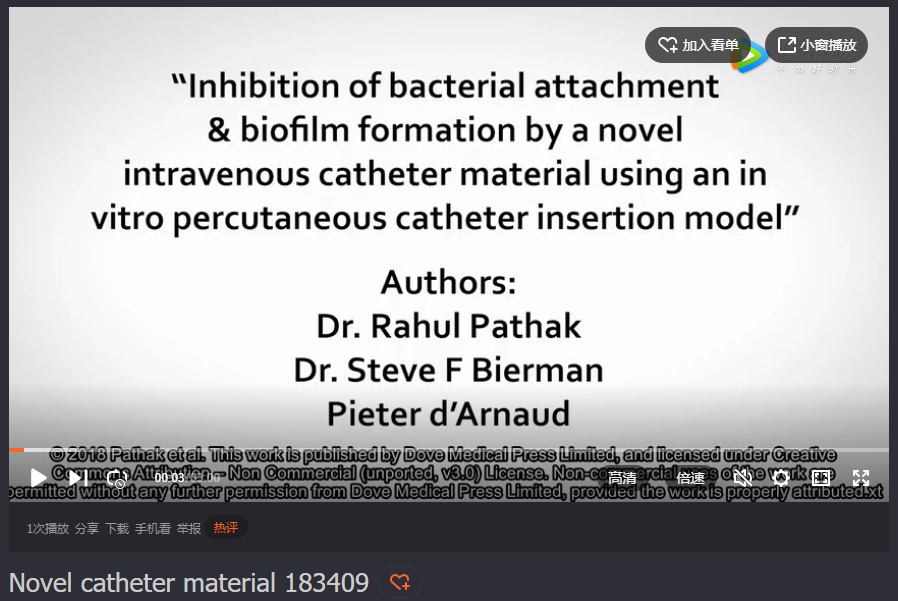9 0 6 7 6
论文已发表
注册即可获取德孚的最新动态
IF 收录期刊
- 2.6 Breast Cancer (Dove Med Press)
- 3.9 Clin Epidemiol
- 3.3 Cancer Manag Res
- 3.9 Infect Drug Resist
- 3.6 Clin Interv Aging
- 4.8 Drug Des Dev Ther
- 2.8 Int J Chronic Obstr
- 8.0 Int J Nanomed
- 2.3 Int J Women's Health
- 3.2 Neuropsych Dis Treat
- 4.0 OncoTargets Ther
- 2.2 Patient Prefer Adher
- 2.8 Ther Clin Risk Manag
- 2.7 J Pain Res
- 3.3 Diabet Metab Synd Ob
- 4.3 Psychol Res Behav Ma
- 3.4 Nat Sci Sleep
- 1.9 Pharmgenomics Pers Med
- 3.5 Risk Manag Healthc Policy
- 4.5 J Inflamm Res
- 2.3 Int J Gen Med
- 4.1 J Hepatocell Carcinoma
- 3.2 J Asthma Allergy
- 2.3 Clin Cosmet Investig Dermatol
- 3.3 J Multidiscip Healthc

Inhibition of bacterial attachment and biofilm formation by a novel intravenous catheter material using an in vitro percutaneous catheter insertion model
Authors Pathak R, Bierman SF, d'Arnaud P
Received 29 August 2018
Accepted for publication 9 October 2018
Published 19 December 2018 Volume 2018:11 Pages 427—432
DOI https://doi.org/10.2147/MDER.S183409
Checked for plagiarism Yes
Review by Single-blind
Peer reviewers approved by Dr Colin Mak
Peer reviewer comments 2
Editor who approved publication: Dr Scott Fraser
Introduction: Despite
sterile barrier precautions and vigorous skin antisepsis, percutaneous
insertion of intravenous catheters has been shown to result in attachment to
the catheter surface of bacteria residing in the deep structures of the skin.
Such attachment poses the risk of biofilm formation and eventual
catheter-related bloodstream infection (CRBSI). This study was undertaken to
assess whether the non-coated surface treatment of a unique catheter material
(ChronoFlex C® with BioGUARD™) could inhibit bacterial
attachment and biofilm formation.
Methods: A
novel in vitro model and fluorescence microscopy were used to compare two
intravascular catheter materials with respect to bacterial attachment and
biofilm formation. The control material was a commonly used polyurethane. The
study material was a unique copolymer, treated so as to remove surface
additives, alter hydrophobicity and create surface micro-patterning. Outcomes
were assessed using both a membrane potential indicator and a cell death
reporter with appropriate fluorescent channels. Thus, bacterial cells attached
to the catheter surface (living and dead) were imaged without mechanical
disruption.
Results: Both
bacterial attachment and biofilm formation are significantly inhibited by the
study catheter material. In fact, over 5 times more bacteria were able to
attach and grow on the control polyurethane material than on the study material
(P =0.0020).
Moreover, those few bacteria that were able to attach to the study material had
a 1.5 times greater likelihood of dying.
Conclusion: Using
a novel in vitro percutaneous catheter insertion model, ChronoFlex C with
BioGUARD is proven to significantly inhibit bacterial attachment and biofilm
formation as compared with a commonly used polyurethane catheter
material.
Keywords: biofilm,
CRBSI, CLABSI, catheter-related infections, catheter-associated infections,
bacterial resistance
摘要视频链接:Inhibition of
bacterial attachment by a novel catheter material
